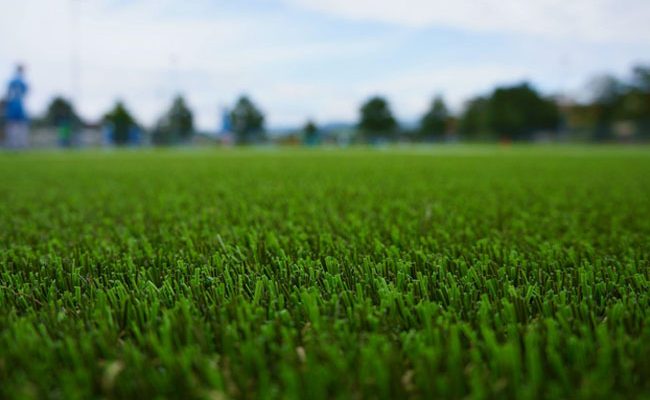
Turf installation requires careful preparation. Leveling out your surface with the builder’s sand is essential; use a landscaping rake and tamper to compact it further.
As the final step, using a drop spreader to apply infill material will prevent weeds and maintain a uniform-looking lawn.
Preparation
An artificial lawn requires a strong base for it to flourish successfully. A rock base will help with drainage and how it feels underfoot; depending on your location, a layer of rubber shock pad or self-leveling compound might also add another level of safety.
As part of your preparations, it is vital that the installation area be free from grass, dirt, and debris. Spraying it with weed killers may help kill unwanted plants at their roots.
Once the soil is cleared away, use a landscaping rake to create an even surface for your base material. Next, grade any flat surfaces of your pad with a 2-3% slope down towards your drainage system or curb; this will ensure water drains properly from artificial turf installation without pooling. Pooling could require costly repairs later. You can visit this site for more information.
After you have prepared the base, silica sand can be spread on it to provide a solid surface for your turf to lie on and reduce heat retention and aid traction. Next, an anti-weed barrier layer should be added on top to limit any future growth of grass seedlings or weeds.
Installation
Turf requires a sturdy foundation to remain level and stable. A four-inch layer of class 2 road base rock or similar material should be laid, leveled off using a rake, and compacted thoroughly using a plate compactor (passing it three or four times).
Although it is possible to install turf directly on dirt, this approach will not yield an appealing lawn that resembles real grass. Weeds will appear and penetrate through, making it challenging to achieve a uniform, clean look without additional steps. You can click the link: https://www.hgtv.com/make-your-own-natural-weed-killer for more information about natural weed killers.
Once a base is laid, a weed barrier fabric should be placed over it to help prevent unwanted vegetation from emerging in the future.
Once this step is completed, an infill layer should be spread on top of the turf by its manufacturer, which will specify how many pounds per square foot of infill is necessary to provide support and create a natural-looking appearance. When applying infill with drop-spreaders then brushing into it using hard bristle push brooms is ideal.
Finally, a perimeter border must be installed around the turf to define it and prevent its edges from collapsing over time. This may consist of metal edging, plastic bender board, or even concrete curbing; without this border installed, its edges would sink further into and separate from its soil bases.
Maintenance
Artificial turf installation provides an ideal alternative to natural lawns that demand high water bills, and an inordinate amount of work yet requires ongoing care for maximum aesthetic and health benefits. Although artificial turf does not need mowing or fertilization, it will still accumulate dust and debris over time. Simply using your garden hose regularly will keep it looking neat.
If you have a permanent barbecue pit or fire pit, it is recommended to install a buffer of concrete or brick between it and any artificial turf to ensure that errant embers or sparks from burning coals do not harm or melt your fake grass. Professional installers can advise on appropriate spacing requirements.
Once your landscaping plan has been determined, the next step should be deciding on a type of synthetic turf for your yard. There are three primary varieties: nylon, polypropylene, and polyethylene. Nylon offers the softest and most realistic experience while polyethylene strikes an excellent balance between durability and realism; in addition, it offers stringent safety standards that make it suitable for children’s playgrounds.
Final Thoughts
Installing turf, yourself can be costly. Materials alone for a 500-square-foot project could easily top $2,000; this includes turf itself, weed barriers, and infill. Therefore, professional installation teams should be hired to ensure everything goes according to plan and any potential issues can be detected early on.
Turf manufacturers have made great strides over time to make artificial grass look more like real turf. While there may still be differences in appearance between real grass and artificial turf, they are much less evident now than they were when The Brady Bunch was still on the air and the kids had to pretend to mow the lawn.
The price for turf depends on its quality and type. Polypropylene turf is often the more economical choice; however, its durability cannot match other options. Though it is ideal for shaded areas or indoor use, polypropylene does not withstand high temperatures or foot traffic as easily. Other more costly turf options may withstand any extremes in the weather.
Artificial turf requires minimal upkeep compared to its natural lawn counterpart, requiring only periodic chemical application for weed-killing purposes and minimal tree sap and gum accumulation on it.
Tree sap or gum accumulation is easy to clear off using either dry ice or aerosol refrigerants before scraping it off with your garden tools. In addition, drains help eliminate dog urine spots on natural grass as the turf drains well.
There are many reasons people choose to install artificial turf at their homes or business. Some seniors choose artificial turf as a way to ensure their yard remains green and attractive year-round with minimal effort. Others are looking for ways to help save the environment by cutting back on watering their lawn. No matter your reason, with proper installation, you will be sure to enjoy your new lawn for years to come.
Leave a Reply